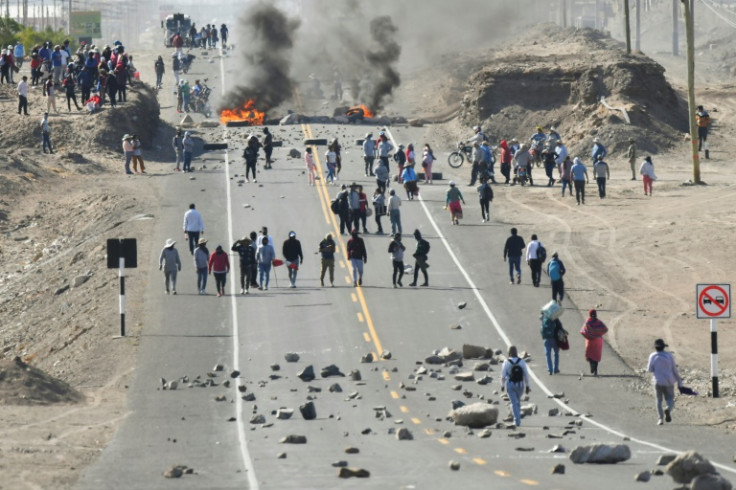Peru Mourns People Killed In Protests Amid State Of Emergency

Peru's capital Lima and three other regions were under a state of emergency Sunday, with deadly weeks-long protests against President Dina Boluarte showing no signs of abating.
At least 42 people have died, according to Peru's human rights ombudsman, in five weeks of clashes at burning roadblocks to demand fresh elections and Boluarte's resignation.
She took over on December 7 as the South American country's first woman president following the impeachment and arrest of Pedro Castillo for a failed bid to dissolve Congress and rule by decree.
Castillo, a leftist former rural school teacher and union leader, faced vehement opposition from Congress during his 18 months in office and is the subject of numerous criminal investigations into allegations of widespread graft.
His ouster sparked immediate nationwide protests, mainly among the rural poor, that petered out over the holiday period but resumed on January 4.
The government extended by 30 days a state of emergency from midnight Saturday for the regions of Lima, Cusco, Callao and Puno, authorizing the military to back up police actions to restore public order.
The state of emergency also suspends constitutional rights such as freedom of movement and assembly, according to a decree published in the official gazette.
More than 100 stretches of road remained blockaded Sunday in 11 of Peru's 25 regions -- a record according to a senior land transport official.
Dozens of people attended a mass Sunday in Lima's central cathedral for the fallen among the protesters as well as a policeman burnt alive in the city of Juliaca on the border with Bolivia.
Many of the mourners wore white T-shirts to symbolize peace, and bore photographs of the dead.
Lima Archbishop Carlos Castillo led the service in Spanish and the Quechua Indigenous language.
The unrest has been largely concentrated in the southern Andes, where Quechua and Aymara communities live.
The Inter-American Commission on Human Rights has said that in order to end the crisis, these groups need to be better integrated into Peruvian society.
Jose Muro, deputy minister of territorial governance, told TV Peru Sunday the government would create "spaces for dialogue" countrywide to discuss unanswered social demands.
"Tell our brothers that this week we intend to establish spaces for dialogue to begin meeting the demands," he said.
Mass demonstrations have meanwhile been announced for Monday in Lima as well as the marginalized southern Andean regions.
On Saturday night, dozens of demonstrators arrived in the capital's Miraflores district as part of a mobilization for a "takeover of the city".
The airport in Cusco, gateway to the famed Machu Picchu site, reopened Saturday after being shuttered two days earlier, the second time it had been closed due to the protests.
Train services to the Inca citadel resumed on Sunday.
Unions say the tourism industry was losing up to seven million sols (1.7 million dollars) a day.
Peru has been politically unstable for years, with 60-year-old Boluarte the country's sixth president in five years.
Castillo has been remanded in custody for 18 months, charged with rebellion among other crimes.
The authorities insist radical groups are behind the protests, including remnants of the Shining Path communist guerrilla group.
As proof, they have presented the capture this week of a former member of that organization, Rocio Leandro, known within the group as "Comrade Cusi."
According to police spokesman General Oscar Arriola, Leandro financed the unrest that left a dozen dead in the Ayacucho region.
He called Leandro "a Marxist, Leninist, Maoist assassin."
© Copyright AFP 2024. All rights reserved.




















